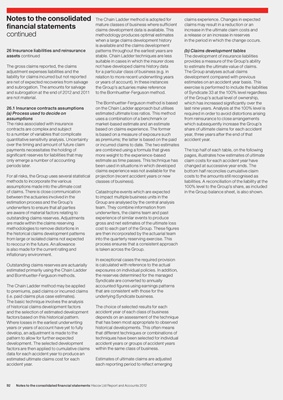
Notes to the consolidated The Chain Ladder method is adopted for claims experience. Changes in expected
financial statements mature classes of business where sufficient
claims development data is available. This
claims may result in a reduction or an
increase in the ultimate claim costs and
continued methodology produces optimal estimates a release or an increase in reserves
when a large claims development history in the period in which the change occurs.
is available and the claims development
26 Insurance liabilities and reinsurance patterns throughout the earliest years are (b) Claims development tables
assets continued stable. Chain Ladder techniques are less The development of insurance liabilities
suitable in cases in which the insurer does provides a measure of the Group’s ability
The gross claims reported, the claims not have developed claims history data to estimate the ultimate value of claims.
adjustment expenses liabilities and the for a particular class of business (e.g. in The Group analyses actual claims
liability for claims incurred but not reported relation to more recent underwriting years development compared with previous
are net of expected recoveries from salvage or years of account). In these instances estimates on an accident year basis. This
and subrogation. The amounts for salvage the Group’s actuaries make reference exercise is performed to include the liabilities
and subrogation at the end of 2012 and 2011 to the Bornhuetter-Ferguson method. of Syndicate 33 at the 100% level regardless
are not material. of the Group’s actual level of ownership,
The Bornhuetter-Ferguson method is based which has increased significantly over the
26.1 Insurance contracts assumptions on the Chain Ladder approach but utilises last nine years. Analysis at the 100% level is
(a) Process used to decide on estimated ultimate loss ratios. This method required in order to avoid distortions arising
assumptions uses a combination of a benchmark or from reinsurance to close arrangements
The risks associated with insurance market-based estimate and an estimate which subsequently increase the Group’s
contracts are complex and subject based on claims experience. The former share of ultimate claims for each accident
to a number of variables that complicate is based on a measure of exposure such year, three years after the end of that
quantitative sensitivity analysis. Uncertainty as premiums; the latter is based on the paid accident year.
over the timing and amount of future claim or incurred claims to date. The two estimates
payments necessitates the holding of are combined using a formula that gives The top half of each table, on the following
significant reserves for liabilities that may more weight to the experience-based pages, illustrates how estimates of ultimate
only emerge a number of accounting estimate as time passes. This technique has claim costs for each accident year have
periods later. been used in situations in which developed changed at successive year ends. The
claims experience was not available for the bottom half reconciles cumulative claim
For all risks, the Group uses several statistical projection (recent accident years or new costs to the amounts still recognised as
methods to incorporate the various classes of business). liabilities. A reconciliation of the liability at the
assumptions made into the ultimate cost 100% level to the Group’s share, as included
of claims. There is close communication Catastrophe events which are expected in the Group balance sheet, is also shown.
between the actuaries involved in the to impact multiple business units in the
estimation process and the Group’s Group are analysed by the central analysis
underwriters to ensure that all parties team. They combine information from
are aware of material factors relating to underwriters, the claims team and past
outstanding claims reserves. Adjustments experience of similar events to produce
are made within the claims reserving gross and net estimates of the ultimate loss
methodologies to remove distortions in cost to each part of the Group. These figures
the historical claims development patterns are then incorporated by the actuarial team
from large or isolated claims not expected into the quarterly reserving exercise. This
to reoccur in the future. An allowance process ensures that a consistent approach
is also made for the current rating and is taken across the Group.
inflationary environment.
In exceptional cases the required provision
Outstanding claims reserves are actuarially is calculated with reference to the actual
estimated primarily using the Chain Ladder exposures on individual policies. In addition,
and Bornhuetter-Ferguson methods. the reserves determined for the managed
Syndicate are converted to annually
The Chain Ladder method may be applied accounted figures using earnings patterns
to premiums, paid claims or incurred claims that are consistent with those for the
(i.e. paid claims plus case estimates). underlying Syndicate business.
The basic technique involves the analysis
of historical claims development factors The choice of selected results for each
and the selection of estimated development accident year of each class of business
factors based on this historical pattern. depends on an assessment of the technique
Where losses in the earliest underwriting that has been most appropriate to observed
years or years of account have yet to fully historical developments. This often means
develop, an adjustment is made to the that different techniques or combinations of
pattern to allow for further expected techniques have been selected for individual
development. The selected development accident years or groups of accident years
factors are then applied to cumulative claims within the same class of business.
data for each accident year to produce an
estimated ultimate claims cost for each Estimates of ultimate claims are adjusted
accident year. each reporting period to reflect emerging
92 Notes to the consolidated financial statements Hiscox Ltd Report and Accounts 2012